A few days ago, I participated in one of my favorite HF contests, CQ WW DX Contest CW. Actually, it was only the second time I participated in this contest, but I regularly try to participate in CQ WW DX Contest SSB as I do not master Morse code.
First trials with Morse code decoder
A few years ago, when I bought SDR FlexRadio 6300, I tried it for the first time. I don't have the log with me anymore, but with the help of the computer, I made enough connections to be the first in the category - all band even in a sweater. However, I made a fundamental mistake back then, I sent the log incorrectly. Reassigning the log to the single band category did not mean any success.
New goal for CQ WW DX Contest CW
But this time I wanted to change it. I remember how much I enjoyed it! It was definitely super easy to make a connection in CW mode compared to SSB, especially when transmitting with reduced power to 5W.
Versatower antenna tower
My preparation started at the end of June when I ordered a new Versatower - 12m tower from Poland and a 3-element 5-band directional antenna from SP7GXP. Everything was waiting for me at home upon my return from Asia. All that was left was to dig a huge hole, put 2 tons of gravel and 26 bags of cement in it, and the tower could stand. Here I have to thank Viliam OM0AAO, who helped me a lot with the tower, without whom I really couldn't have done it.
SP7GXP antenna
I built the sign. It was interesting, but I was surprised by the quality of the design of this SP7GXP antenna and slowly I gave it in the weekend. And I think I have done a good job. The mast helped me to give it the mayor of the village, for which I am also very grateful to him. As two of us we did it in half an hour and I could shoot it into the rich. See the following photo what it looks like. And yes, the antenna is dimensionally larger than my house 🙂
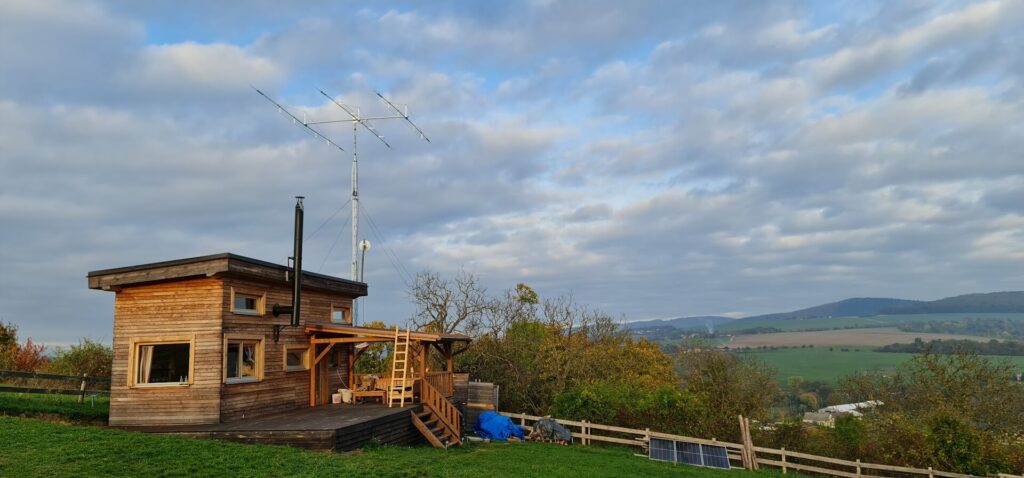
FAN antenna
Due to work busyness, I started preparing for the CQ WW DX Contest CW only on Friday morning, just a few hours before it started. I also wanted to make a FAN antenna for 160/80/40m. I started building it early in the morning, but due to the lack of material, I didn't even have a way to mount it balun and simply - I was already running out of time. Although I carefully measured each arm of the dipole and soldered everything as it should be, darkness came and I still didn't have the software set up and I wasn't even decided on which category to go
Fortunately, about a week before, I put my Butternut vertical (80-10m) in the center of the garden, added 12 radials, and ran a cable to the cottage.
The decision on which category to go didn't even come up. I wanted to try all bands, and if I made more quality connections on some, I would only submit those, otherwise it would be all bands.

Powering the radio station with solar panels
Whether I will go QRO, Low-Power or QRP wasn't on the table - I had to go QRP. Why? Because I live in a cottage that is not connected to the electrical grid and everything I consume I have to produce myself. At the moment, I only had 3 solar panels with a theoretical maximum of 1.2kw, plus 3000W inverter So I have antennas. Both work beautifully - a beam for 20m - 10m and I wanted to use the vertical for 80/40, and with a tuner if I manage a few connections even on 160m.
So I have antennas. Both work beautifully - a beam for 20m - 10m and I wanted to use the vertical for 80/40, and with a tuner if I manage a few connections even on 160m.
SDR TCVR SunSDR2 Pro
Technically, in terms of antennas, I was equipped. As for the TRCV, I had the SunSDR2 Pro - a small box, but great performance.
What is TCI Expert Electronics for?
Around eight in the evening I started to “solve” the software side. In the previous competition - CQ WW DX SSB Contest it was easy. I just needed ExpertSDR software on my MacBook Pro computer and RumLog, which gets along very well with it and communicates via TCI (Transceiver Control Interface), which is a special protocol developed by Expert Electronics company that simplifies everything - you don't need to worry about any COM ports or anything like that.
Can you compete without mastering Morse code (CW)?
But since this will be a competition, using a mode that I don't actually control, I had to set up the system so that I could effectively decode the Morse code of other stations and also respond to them and make the right connection with everything that goes with it.
Failure with SDR software, CW skimmer, and N1MM+
First, I tried to get an older laptop running Windows 10, but when I wanted it to run SDR software at the same time as N1MM+, it just didn't work. It was very slow, not to mention the CW skimmer I wanted to use.
Solution with SDC software UT4LW
I had no choice but to take back my MacBook Pro and start configuring. Fortunately, I already had the SDC software (https://www.lw-sdc.com) from UT4LW that has built -in CW skimmer server and rumlog (https://dl2rum.de/rumsoft/rumlog.html) from DL2RUM. As SUNSDR2 Pro Radio Software, only ExpertSDR software is available for the SunSDR2 Pro Radio. (https://eesdr.com/en/software-en/expertsDR2-en) from Expert Electronics.
Working with RumLog software
What took me long hours of testing and experimenting was setting up the Rumlog software correctly for sending CW.
Advantage of TCI
In fact, the whole connection of SDC + RumLog + ExpertSDR2 is extremely simple, as all 3 softwares communicate via the TCI protocol. In ExpertSDR2 you just enable TCI, in SDC the same, it already knows on which port it works, so again it's one “tick” and in Rumlog, the setting is very simple, see screenshots.
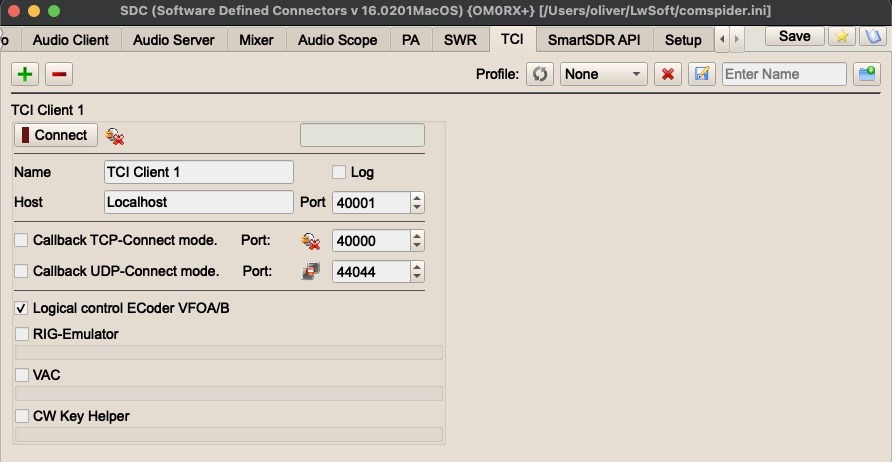
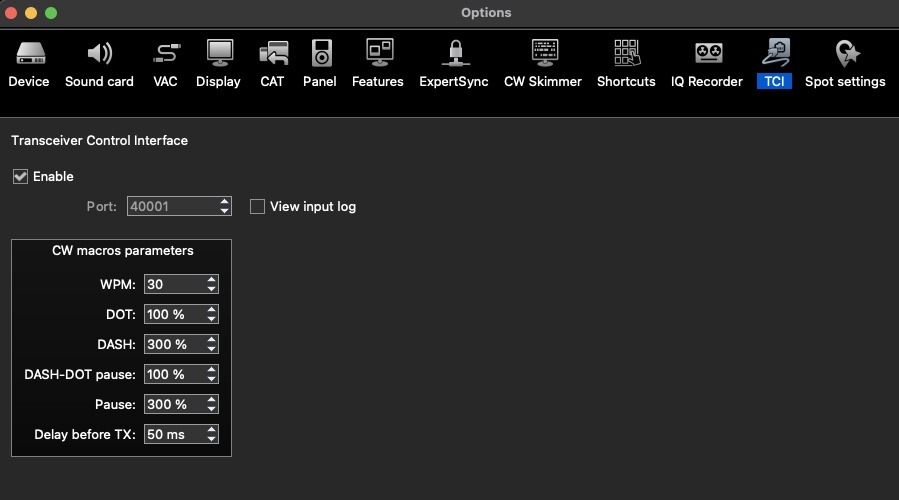
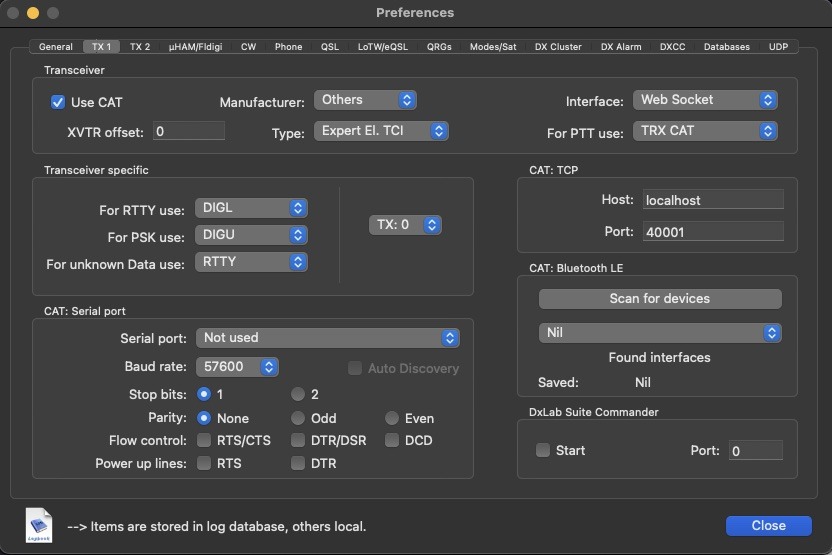
Morse code transmission and Telnet server
But there was a problem with sending Morse code. As you can see in the following screenshot, the system is absolutely brilliant! I even used the second feature of the SDC software, which is its own telnet server!
The principle of operation for decoding and transmitting Morse code
It worked as follows:
- SDC decoded CW signals. It handled the entire CW spectrum on the band at once and according to external tests, I knew it was better than CW skimmer on Windows, which pleased me.
- Individual stations were then stored in SDC's own cluster, I then configured Rumlog software to simply not connect to an external cluster, but to my own.
- Rumlog has another feature - it can move spots directly to ExpertSDR2 software, so you can see beautifully what you need, what you don't, where everyone is, simply great!
In Rumlog, you can configure various CW macros and effectively transmit using just the keyboard, you don't even need a CW key (just like in N1MM+).
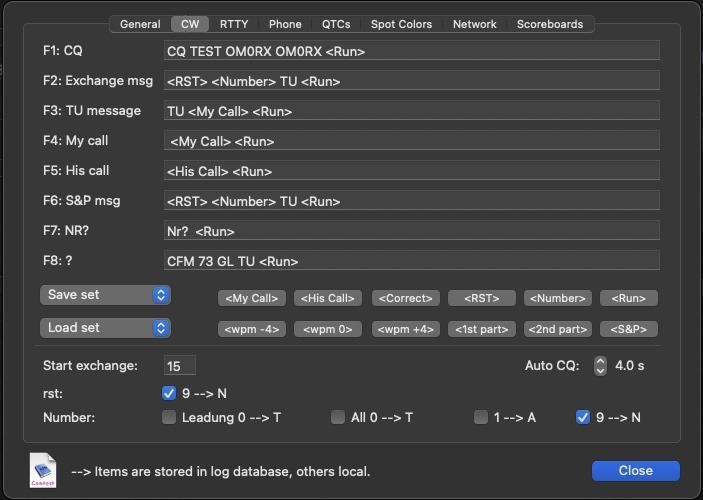
Sending Morse code from the keyboard
As I write, I struggled with macros in Rumlog. It simply didn't do what it was supposed to, and after hours of testing (regarding the manual, it is very weak in this and doesn't explain much). Finally, I found that just adding “[Run]” after each macro solved my problem.
During the whole competition, I used only 2 macros. It was absolutely enough, and they were these two specific ones:
[My Call] [RUN]
[RST] [NUMBER] HERE [RUN]
Amazing, right? Rumlog had another amazing feature, which was that it showed the decoded station directly in the logging window, so I didn't have to look anywhere else. Throughout the competition, I managed with two windows - the band map and the logging window. In the band map, I saw all the stations that the cluster moved for me, which were decoded by the CW skimmer in the SDC software. Of course, Rumlog already knew which ones I missed, which ones I made, which ones were multipliers - amazing, all nicely color-coded.
The advantage of your own cluster
And another immense advantage was that in the cluster, I didn't have anything that my antenna didn't hear and that my software didn't decode. And it was confirmed to me 100% by the fact that I practically made 99% of the stations, some were harder, with a QRP signal I had to fight in the pile-up, but to my surprise, I would say that I made 50% of the connections on the first call.
The following screenshot will show you everything in one place - band map, logging window, SDR software. You can also see how it is decoded there, directly in the window where it is written Regarding color differentiation of contacts, red color means I have already made contact with that station, green means I need it, and blue means it's a multiplier, either zone or new country. So I knew very well which contacts I needed to focus on.. As for the color resolution of contacts, the red color means that I have already made a connection with the station, green, that I need it and blue, that it is a multipower, either a zone or a new country. So I knew very well, which connections I had to focus on.
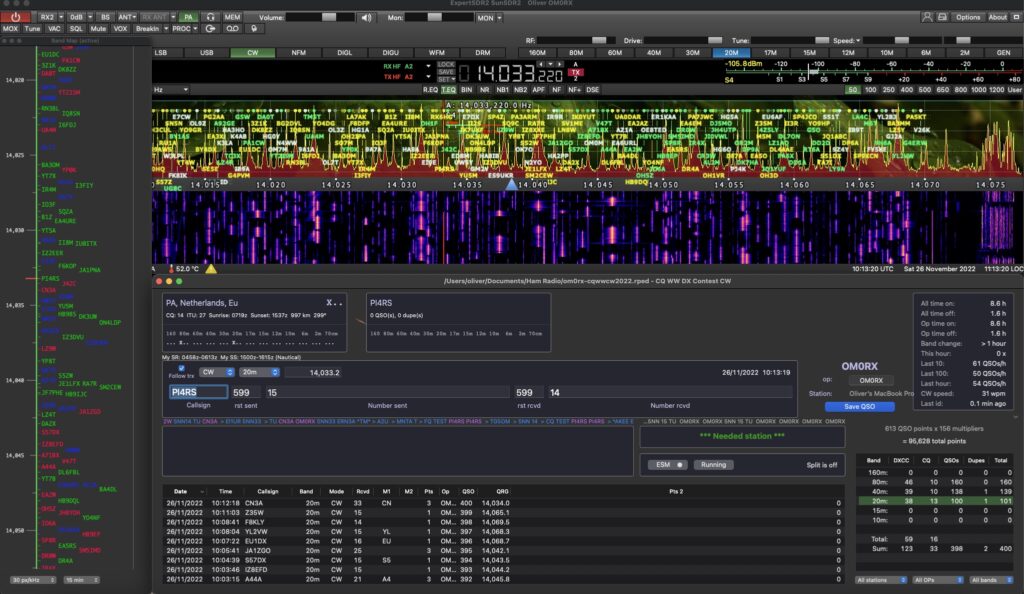
How did the contest progress on my side?
In the band map, I clicked on the station I wanted to make contact with.
I waited for the station to finish the contact with the previous station, most of them ended with 'TU K4ZD,' a thank you and callsign. Then I knew it was my turn and pressed the macro with ' '
A good feature of the software was that it knew at what speed the station was transmitting and automatically set it! Isn't that great? So I transmitted from 25wpm to 38, mostly I noticed that most stations were around 30wpm. Russian stations went much faster, and 38wpm was not uncommon.
After sending my callsign, I read and listened to see if the station would respond. Most accepted my full callsign the first time. Others gave, for example, 'RX?' or 'OM?', or another combination or just 'X?'
I knew it was my turn, and I called the macro again.
Back, I already 'received, for example, '599 5 TU', but mostly it was '5NN 5 TU,' which is a bit shorter.
Then I pressed the key with the second macro and replied '599 15 TU'.
And that was it! I still waited to see if the other station wanted my response again, but usually, 95% of the time it passed the first time, and I could move on - back to point 1!
And no, I really don't master Morse code (is there anyone here who can help me learn it? The interest is here). But don't think it can be done without 'listening,' especially in such a contest.
There were many connections when the CW skimmer didn't decode everything correctly, either because of QRM or QRN. In that case, I really had to recognize my callsign and the rest. But since it repeated, it was possible, believe me. Especially in pile-ups, it was difficult, and I logged enough connections even without seeing it decoded, but from hearing (yes, even at 30wpm) I knew they took me and gave TU at the end, etc. …
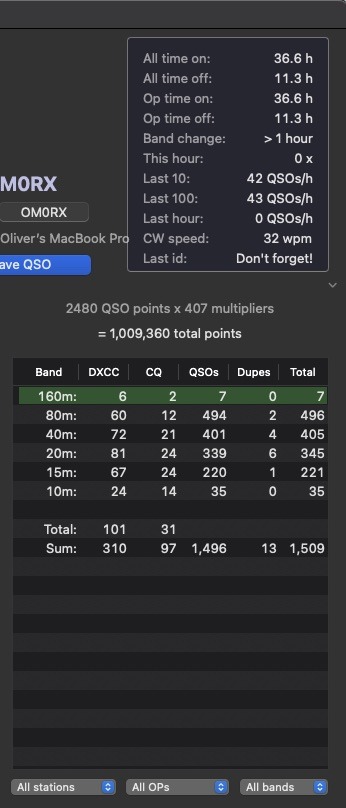
CQ WW DX Contest is also about fatigue and endurance - evaluation
In the end, I ended up spending over 36 hours out of 48 behind the station, making 1509 connections on all bands, only a few on 160m, as I didn't have an antenna for that band (I made 7 connections there).
But I was surprised by my vertical, from which I didn't expect what it allowed me to do. See the screenshot of my statistics, but I'll write that I actually made the most connections on 80m, 494 to be exact! My second band was 40m, where I made 401 connections. So yes, here you can see that with a simple antenna and QRP power in a contest, you can make hundreds of connections.
The rudder worked amazingly - it has already confirmed me in the previous competition. It is 12m high, but it has its advantages and disadvantages. The advantages you all know, but the disadvantage was its direction. You have to spin and this is also losing a lot of time and I could clearly make connections faster to 80/40 bands than 20-10. When I did not have a director directed to the direction, I did not even know if there was someone interesting, as I did not use an external cluster. Here you need to use your knowledge and experience, you need to know which direction is open at a given time, where the antenna direct to get the most connections and points, etc. But this article cannot cover everything, so perhaps next time.
I must conclude that I liked it. I really didn't expect to make 1500 connections. I'm already looking forward to the next CW contest.
If anyone has any questions about software and antennas, I will gladly answer them, feel free to comment on this article.
Finally, I would like to say that I am glad that as a native Slovak I could finally broadcast from my own QTH in Slovakia. And I broadcasted with a smile. In previous contests, I went from Wales (GW as MW0JRX, MC0SHL) and from Australia (VK as VK8DX, VK5RK and VK2YI). I stopped by Slovakia a few times and broadcasted with Viliam OM0AAO, for which I am very grateful. Thank you!
73! de Oliver OM0RX
P.S.
I attach the final screenshot of the screen a few seconds after the competition.
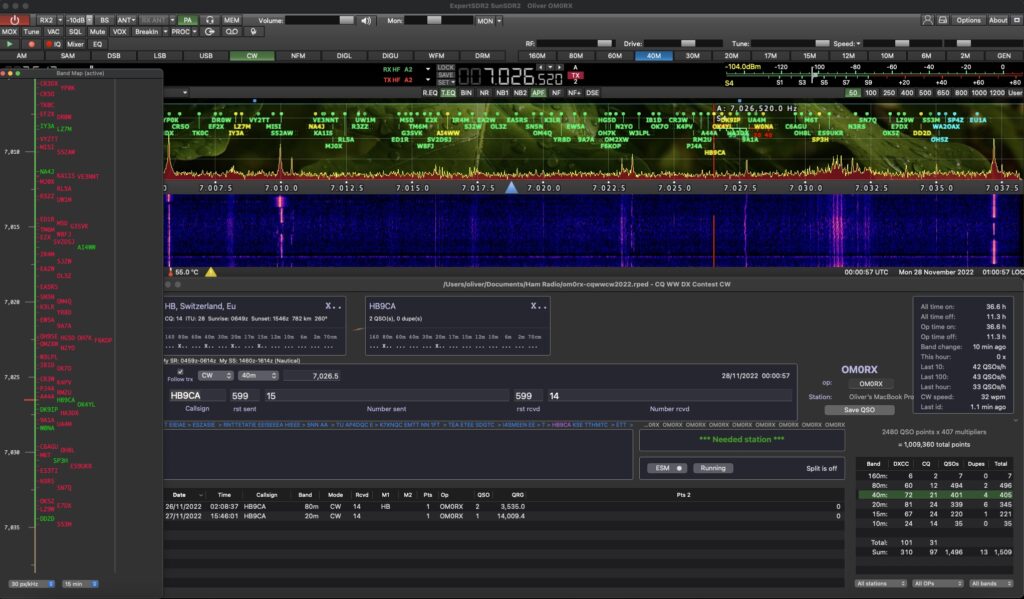
P.S.2
And for those who like to look at different screens, I have statistics here:
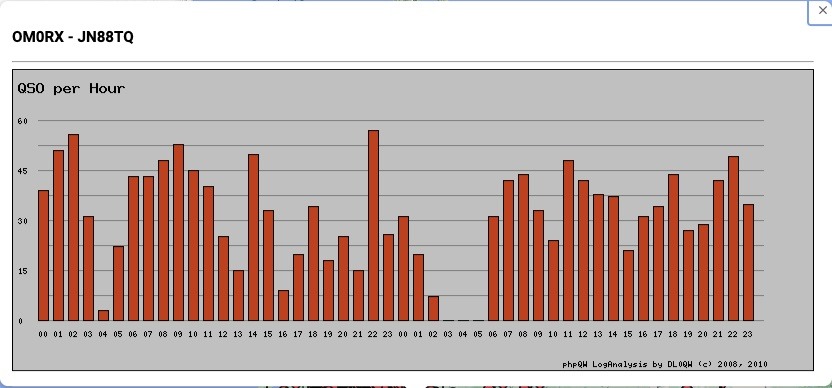
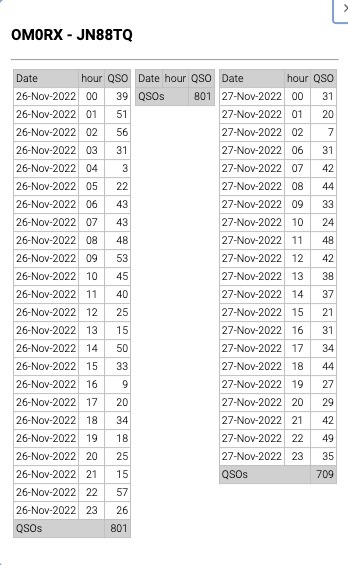
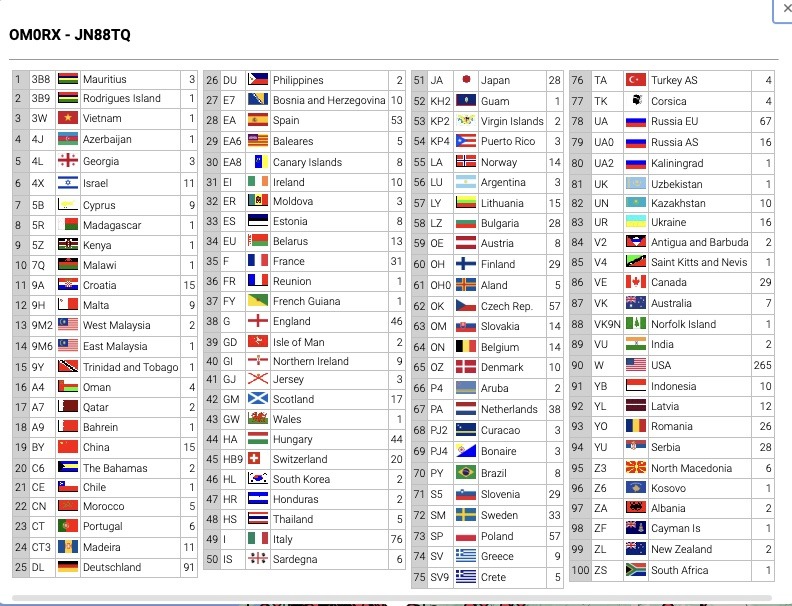
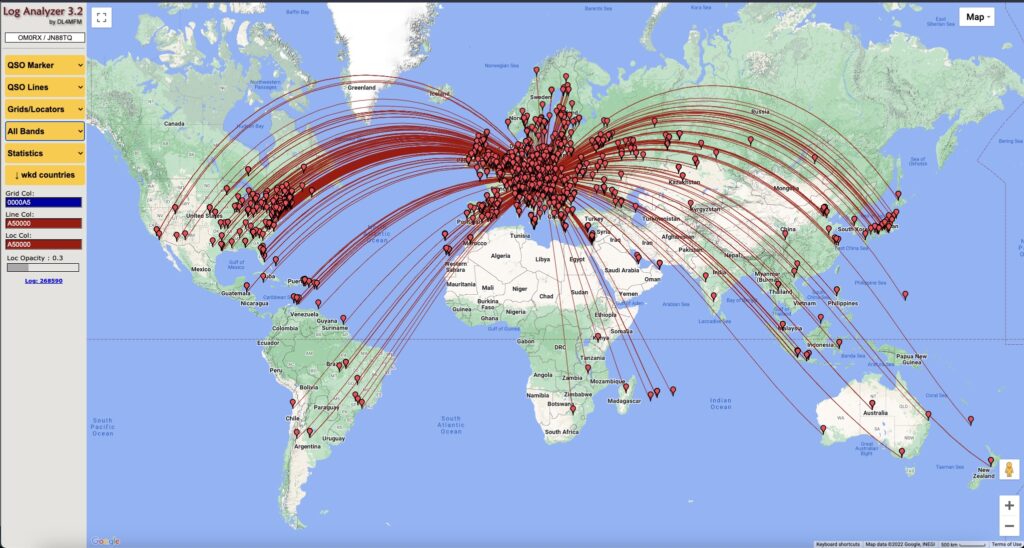
You have a beautiful qth, i also have occasional QTH in Podkylava
Oh, that's great, so stop sometimes, I'm just under the prospect of Pavicie, when you get into Google Maps: "Red Dingo Homestead" and you just find me 🙂
Very interesting and inspirative article. Thank you and wish you a lot of success on the pas.
Rudo
Thank you Rudko for a nice comment 🙂
If I can advise you, do not call big guns quickly with QRP. Especially in worse propagation conditions and on lower bands, you will go further slowly. In big HF contests, in the range of 24-30 wpm, more is counterproductive. Big guns go faster because they are strong and it bounces off them. And precisely when it doesn't bounce off, they shouldn't go unnecessarily fast either. What you mention about the Russians is a bad habit when they call futile CQs with 38 wpm. Many stations are not even able to understand it, especially in worse conditions (weak signals, scattered across the northern hemisphere).
Small advice regarding power supply.
If you have a complete solar island system with the power and capacity as you describe, I recommend a small power plant with a combined starting system.
Detailed description of how to achieve it cheaply and self-sufficiently.
So the EC can be started manually, with a rope, and also on a battery.
Add a remote small keychain controller for starting, it will reliably start up to 100m.
Just add relays, one for ignition and the other for the starter,
A module from China that can be set for one button permanently on/off and the other button as a starter button.
Extension drum, at least 20m 3x 1.5mm cross-section, so that the EC does not collapse near the cottage.
Entry into the solar system, charging, here I will give the following recommendation.
Do not use switched power supplies or chargers, but..
If you have a powerful MPPT converter, it is good to connect it to the panel input of the converter through a quality isolation transformer and a classic rectifier with filtration, using one isolating diode for charging from the EC.
It is necessary to adhere only to the maximum input voltage for the MPPT regulator, that is, the voltage at idle on the transformer with the rectifier, so that it does not have unnecessarily higher voltage.
The regulator will take it according to its own needs, optimally load the EC, and during the operation of the EC, it will not go idle.
The advantage of the transformer is that you galvanically separate the output of the EC by 100%, you also eliminate any interference that could occur on a simple or electronic regulator and push into the system from the EC to the "onboard network" of the island system.
When you monitor the voltage or status on the MPPT, you know when you can turn off the EC, or when to turn it on, possibly in reality it will run a maximum of 3 times in 24 hours for two, max 3 hours, Probably 2x at night and once during the day, if the system is well dimensioned because if the EC is 1-1.5kW, the transformer is at least 1kW, so at this power, you will replenish the batteries quite quickly.
Ideally, as a transformer, use a larger transformer, or an old ready-made charger, for backup batteries, emergency lighting, or traction batteries for telephone exchanges, etc.
If you have a 1.2kWp solar system, then you probably have a sufficiently sized converter, so there should not be any big problem connecting it.
EC is also suitable for other small jobs, when a generator and solar power are not enough (washing machine.. angle grinder, mixer.. lack of light in winter)
…
The cheapest generator was once a Parkside from Lidl, PSE 2800 A1. It cost me 150 euros, unpacked in the store. It was missing a spark plug wrench, funnel, and probably also instructions.
One day they stole the modified one from my car, but I found another one in the ad, I didn't modify this one, there was no time or need.
When I was doing various jobs outside in a place where there is no electricity connection and solar power was not needed.
I bought a kit from Aliexpress for the electric starter for the generator, it's a pretty primitive thing, it includes changing the ignition magnet rotor, where there is a toothed ring for the starter, the starter itself, and a control box (a piece of metal with a key)
Similarly from Aliexpress, a set of 2 x two-button key fobs with a retractable antenna and a receiver, which was powered by 12V and two relays, which could be set separately either for bistable or monostable control of the output.
It is very comfortable, very expensive generators have it, for example, Honda, or others, because the key fob in the pocket, during normal work, allows the unnecessary generator to stop running, but start it as needed, for the time required for operation.
The first start still usually needs to be done manually because you need to turn on the fuel and usually after a long time the battery is dead and doesn't crank happily.
After the first start and about half an hour of running, the battery in the generator is already charging, in the following start even after several hours, if it's not freezing cold, you don't need to turn on the fuel, at least that's the experience.
This generator PSE 2800 A1 managed to power even a welding inverter, outside in the field and even a plasma cutter, but first the compressor had to be pressurized and only then the plasma ignited.
It is basically a copy of a copy of a Honda engine and also the whole wiring, even the regulation, is like Honda. It managed to run continuously at an output of 12A, on a full tank for about 10 hours. (connected dehumidifier 2.2kW)
At that time, nothing cheaper could be obtained.
Other generators are definitely better, especially from Honda, but significantly more expensive.
A good brand is also Gude, especially those with large wheels, for construction.
They are not so efficient, but they have a power of around 3kW.
I don't know what kit for remote start would need to be installed there.
For permanent and long-term operation, instead of gasoline, I also recommend getting a gasifier for PB from Alika, for EC
If you happen to have a refillable (LPG refillable bottle, for caravans at the pump, original) then for the price of refilled LPG, you have cheaper electricity from EC today, than from the socket, for non-residential areas..
It is not worth solving exchangeable bottles, because the gas in exchangeable bottles is 3 times more expensive than refilled LPG and it turns out cheaper than regular natural gasoline.
Good luck!
OM1ARH
Beautiful place for amateur radio work. Congratulations!
Very good article.